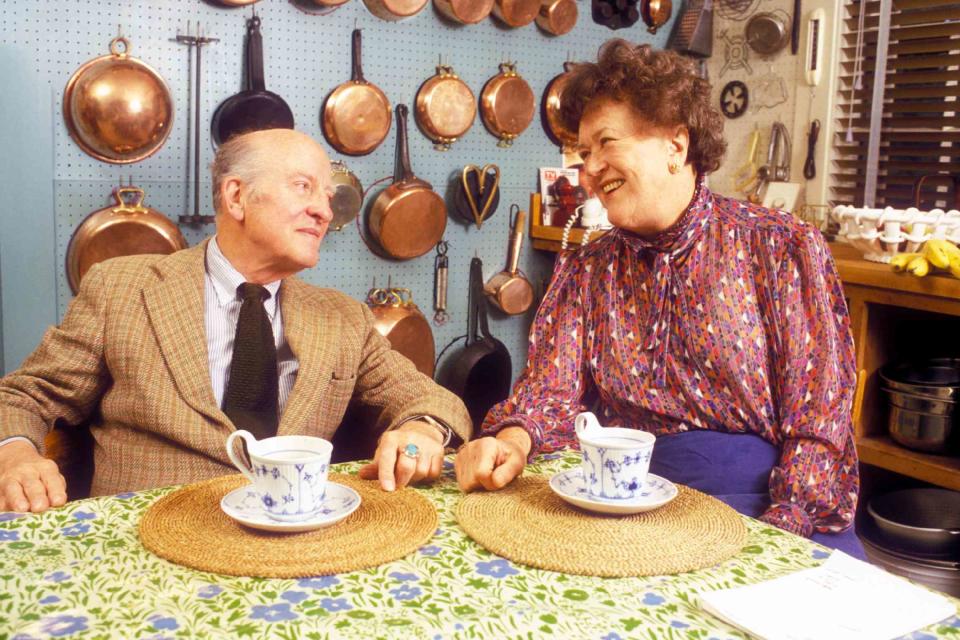You'll Melt Over Julia Child's Adorable Valentine's Day Tradition
Julia and Paul Child sent valentines to their friends for two and a half decades. She wrote about the tradition for Food & Wine.

Rick Friedman / Corbis via Getty Images
Food & Wine columnist Julia Child wrote about her and her husband Paul's valentine tradition in the February 1998 issue .
"Why not send out valentines?" suggested my husband, Paul, back in the late 1940s. We had just moved into our Paris apartment. December was upon us, and it was clear we would never make the Christmas card deadline.
The apartment was a wonderful find — the whole third floor of a private apartment, a hotel particulier. The formal living room was entirely over-furnished with gilt and tapestried Louis XVI furniture, a great deal of which we stored in the maid's room next to the kitchen. Our kitchen was a roomy antique-but-functional two-room affair overlooking the garden of the Ministry of War. Besides our apartment's comfortable size, its situation was ideal, on the Rue de I'Universite, next to the French National Assembly and a nice walk over the River Seine and across the splendor of the Place de la Concorde to the American Embassy, where Paul was working. We also had the metro close at hand — our subway stop was Chambre-des-Deputes — and two autobuses stopped at our corner, on the Boulevard St. Germain. In those days we could even park our old blue Buick on the street right next to our massive front door. We were blissfully fortunate and we knew it.
:
I agreed with Paul that valentines would have to carry our good wishes for the year of 1948. Paul, a fine photographer, decided we should express ourselves in postcard form. If you've ever riffled through the postcard section in the book stalls along the Seine, you will remember those sentimental poses of simpering couples; that's what he had in mind. He rented two wigs, made red hearts out of cardboard, set up his props, arranged his self-timing camera on its tripod, and took two dozen shots of us in various poses. When the pictures came back, a few were out of focus, and others were silly; only two or three had the right simper — serious, loving, sincere, and innocent. He picked the ideal pose, had it printed on postcards with a suitably mauve background and added the words "Valentine for you" in florid gold script. It was perfect. I wish I could show you a copy, but they've all disappeared. Several recipients wrote back to say, "The funny thing about your valentine — that couple in the photograph really look a bit like you!"
:
Always delighted to join with any creative project, Paul decided that valentines were for us and produced a new one every year for at least two dozen Februaries. My part was to make a special Valentine's Day dinner, usually including some kind of duck as the main course. One year I spent weeks on duck for Volume I of Mastering the Art of French Cooking. Paul enthusiastically acted as official guinea pig, but even he admitted that he was "all a-quack" after one long session. He had sketched a beautiful valentine of the two of us flying over the Eiffel Tower in a flamboyant balloon, but he switched to a beautifully rendered duck in full plumage, brandishing in its mouth a large red heart.

One of his more ambitious projects was the Stained Glass Window. As a youth in Boston, he'd worked in the studio of Charles Connick, who made stained-glass windows for churches. When Paul's family moved to Paris in the 1920s, Connick had been chosen to design and mount the windows for the American Church there. Paul was hired to help; he spent weeks swaying on ladders and scaffolding high over the altar. His twin brother, Charlie, frequently came to inspect and to report on the progress of "Tarzan of the Apse."
:
Memories of this perilous period were vivid when we moved to Paris after the war and met a group of medievalists through friends at Yale. Art historians all, they spent their evenings drinking red wine and speculating on such exotica as whether the false transepts of a certain cathedral were to be dated 1123 or 1146. Although much of the talk was beyond me, I was happy to be exposed to the language, and Paul was always impressed by their erudition. He was also inspired to make his own stained-glass window, which he then photographed for one of our valentines. Today the original hangs in the window of my front door in Cambridge, where the light coming through brings out its colorful details.

